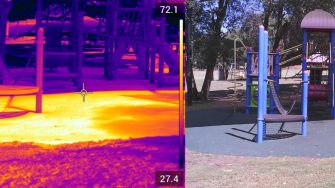
This project is being undertaken by UNSW and Western Sydney University in partnership with Cancer Institute NSW and Cancer Council NSW.
The project is funded by: UNSW Alliances/Project Mezze Seed Funding – Liveable Communities
Acknowledgements: The research team thankfully acknowledges the City of Parramatta Council for the project support and approval to conduct the experimental activity at the three selected playground locations.
Project ethics approval: iRECS4758
Project contacts: r.paolini@unsw.edu.au / S.Pfautsch@westernsydney.edu.au
Background
Playing outdoors is a right of children and especially important for those growing up in urban environments where access to nature is restricted. Well-designed public play areas also provide space and opportunity for connection across genders, socio-economic status, and generations.
However, the combination of global climate change and urban sprawl is worsening urban overheating, which in turn reduces the liveability of outdoor spaces.
This is a particular issue in Western Sydney. Surface temperatures in sun-exposed playgrounds in Western Sydney are often hot enough to burn skin due to insufficient provision of high-quality shade and inadequate materials used for flooring materials and equipment. Inadequate shading also increases the overexposure to UV radiation of children but also parents and supervisors.
This project will investigate the conditions when play in public playgrounds across western Sydney becomes unsafe due to the lack of shade and materials that become too hot. We aim to combine energy flux measurements and environmental monitoring together with assessment of occupancy and human thermal comfort to evaluate the quality and quantity of shade and thermal environment under summer conditions.
Project Objectives
The research is designed to answer the following questions:
- How do quantity and quality of shade and the overall thermal environment affect playground use?
- Are there environmental thresholds for the summertime visitation of playgrounds?
- Which design solutions prolong playground use under a warming climate?
Methods
3 playgrounds have been selected for study, upon consultation with Parramatta City Council, which have similar design and equipment but differing levels of shade.
Short terms measurements at each playground include the measurement at multiple locations and at different heights (0.30 m and 1.1 m) of air temperature, relative humidity, and wind speed. The two measurement heights are representative of crawling children and standing adults. Ultraviolet radiation, surface temperatures and albedo (solar reflectance) of surfaces will also be measured.
Below: Equipment used to measure thermal comfort conditions (left) and to measure ultraviolet radiation (right).
Over several months, measurements will be undertaken of traffic at each playground using smart people counters, and weather conditions using small permanently installed weather stations.
Below: An infrared person counter used to anonymously measure playground visitation.
Benefits
Results will identify thresholds when playgrounds become too hot to play, and the impact of different levels of shading. These results can be used immediately to improve playground shade in Parramatta and beyond.
Findings will be used strategically to approach industry partners, government, and not-for-profit organisations to develop a larger systematic research project that develops basic principles for outdoor playgrounds that will remain safe for children under a warmer climate and consistently high UV radiation.
Below: Surface temperatures measured at different playgrounds in Western Sydney.
Project Investigators
Lead Investigators:
A/Prof Riccardo Paolini, School of Built Environment | Arts, Design and Architecture, UNSW
Prof Sebastian Pfautsch, Urban Management and Planning, School of Social Sciences, WSU
Investigators:
Dr Negin Nazarian, School of Built Environment | Arts, Design and Architecture, UNSW
A/Prof Melissa Hart, ARC Centre of Excellence Climate Extremes, UNSW
Dr Agnieszka Wujeska-Klause, Urban Management and Planning, School of Social Sciences, WSU
Mahya Parchami, School of Built Environment | Arts, Design and Architecture, UNSW
Check our previous research on playgrounds
UV Smart Cool Playground Project
Guide to Climate-Smart Playgrounds: Research Findings and Application
Untouchable playgrounds: Urban heat and the future of Western Sydney

